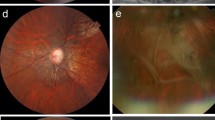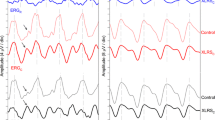Abstract
39 patients suffering from congenital achromatopsia were investigated by various methods, including electroretinography, during both light and dark adaptation. This condition was typically expressed by the presence of photophobia, low visual acuity, nystagmus and various degrees of ametropia. The fundus was normal in 9 cases. Most of the other cases showed various macular or foveal abnormalities. 24 patients showed complete absence of color vision, and practically all displayed the ‘scotopic line’ in the Farnsworth Panel D-15 test.
The electroretinogram (ERG) was almost always extinct in light. In the dark, in most patients the ERG displayed the scotopic mechanism solely, but some ERGs indicated subnormal photopic components either at the beginning or during all dark adaptation. This presence of photopic activity in the ERG of achromats was verified by 2 additional experiments. In one, the recovery of the positive wave of four achromats was compared on a percentage scale with that of four normal subjects and found to be similar, although the slightly faster course in achromats indicates less photopic activity than in normals. In the second, the positive amplitudes of the ERGs of 12 achromats with purely scotopic ERGs were recorded at completed dark adaptation as function of increasing stimulus intensities, all above the photopic threshold, and compared with those of 16 normal subjects. The amplitudes increased linearly with the 1.2 log intensity range in both groups, though the slope of the curve of the achromats was 1/4 that of the normals. In another experiment, the positive wave of the ERG, as elicited by light over 5 log units in the scotopic range, was found in an achromat to be of very similar shape as that of a normal, indicating scotopic acitivity to be similar in both subjects.
The fact that, nevertheless, photopic components were not demonstrable in most ERGs, despite present photopic activity, can be explained by the relatively insensitive electrical method coupled with the subnormality of the retinal photopic mechanism in every achromat.
Similar content being viewed by others
References
aguilar, m. & w. S.stiles. Saturation of the rod mechanism of the retina at high levels of stimulation. Optica Acta. 1: 59–65 (1954).
alpern, m., h. f.fallsg. B.lee. The enigma of typical total monochromacy. Am. J. Ophthal. 50: 326–341 (1960).
alpern, m., g. b.leeb. e.spivey. π1 cone monochromatism. Arch. Opthhal. 74, 334–337 (1965).
auerbach, E. Violet receptor. In Mechanisms of Colour Discrim. Proc. Int. Symp. Paris 1958, pp. 177–182. Pergamon Press (1960).
— L'électrorétinogramme photopique de l'homme. Symp. Jubilaire Jacques Daviel, Marseille, pp, 93–105, Nov. (1962).
— The human electroretinogram in the light and during dark adaptation. Doc. Ophthal. 22: 1–71 (1967).
— The value of the different components for clinical electroretinography. ISCERG Symp. Ghent 1966, pp. 162–173, S. Karger, Basel/New York (1968).
— I. Electrophysiological Examination (Electroretinography and Electro-oculography). II. Clinical application of bioelectrical tests. In Textbook of the Fundus of the Eye by a. j.ballantyne & i. C.michaelson, I. pp. 22–39, 49–50. II. pp. 512–542. E. & S. Livingstone, Edinburgh & London (1970).
— v.godel & h.rowe. An electroretinographical and psychophysical study of two forms of congenital night blindness. Invest. Ophthal. 8: 332–345 (1969).
— & b.kripke. Some studies of rod-monochromatism. EEG Clin. Neutophysiol. 28: 643 (1970).
— & b.kripke. Achromatopsia with amblyopia. II. A psychophysical study of five cases. Doc. Ophthal. 37 (1): 119–144 (1974).
berson, e. L., p.gouras & r.gunkel. Progressive cone degeneration, dominantly inherited. Arch. Ophthal. 80: 77–83 (1968).
blackwell, h. R. & o. m.blackwell. Rod and cone mechanisms in typical and atypical congenital achromatopsia. Vision Res. 1: 62–107 (1961).
bornschein, h., o.goodman & r. d.gunkel. Temporal aspects of the human electroretinogram. Arch. Ophthal. 57: 386–392 (1957).
brown, k. T. The electroretinogram: its components and their origins. Vision Res. 8: 633–677 (1968).
crampton, g. H. & j. C.armington. Area-intensity relation and retinal location in the human electroretinogram. Am. J. Physiol. 181: 47–53 (1955).
creutzfeldt, o., a.rosina, m.ito & w.probst. Visual evoked responses of single cells and of the EEG in primary visual area of the cat. J. Neurophysiol. 32: 127–139 (1969).
dawson, g. d. A summation technique for the detection of small evoked potentials. EEG Clin. Neurophysiol. 6: 65–84 (1954).
devoe, r. g., h.ripps & h. G.vaughan Jr. Cortical responses to stimulation of the human fovea. Vision Res. 8: 135–147 (1968).
dodt, e., g. H. M.vanlith & b.schmidt. Electroretinographic evaluation of the photopic malfunction in a totally colour blind. Vision Res. 7: 231–241 (1967).
—, g. H. M.vanlith & l.wadenstein. The use of flicker electroretinography in the human eye. Acta Ophthal. 32: 165–180 (1954).
duke-Elder, s. System of Ophthalmology. Vol. II: The anatomy of the visual system. Henry Kimpton, London, 1961.
earll, j. M., b. e.spivey & i. R.mattai. Atypical congenital monochromatism. Arch. Internal Med. 118: 491–493 (1966).
falls, h. f., j. R.wolter & m.alpern. Typical total monochromacy: A histological and psychophysical study. Arch. Ophthal. 74: 610–616 (1965).
françois, J. & a. Derouck. Behavior of ERG and EOG in localized retinal destruction by photocoagulation. In Clinical Electroretinography, Proc. 3rd Intern'l Symp., 1964. pp. 191–202. Pergamon Press, 1966.
—, g.verriest & a.derouck. L'achromatopsie congénitale. Doc. Ophthal. 9: 338–424 (1955).
fuortes, m. G. f., r. d.gunkel & w. A. H.rushton. Increment thresholds in a subject deficient in cone vision. J. Physiol. 156: 179–192 (1961).
goldschmidt, e., a.ronen & i.ronen. Changing marriage systems in the Jewish communities of Israel. Ann. Human Genetics 24: 191–204 (1960).
goodman, g. & h.bornschein. Comparative electroretinographic studies in congenital night blindness and total color blindness. Arch. Ophthal. 58: 174–182 (1957).
— & g.iser. Physiological studies with flicker electroretinography. Am. J. Ophthal. 42: 212–226 (1956).
harrison, r., d.hoefnagel & j. n.hayward. Congenital total color blindness, A clinicopathological report. Arch. Ophthal. 64: 685–692 (1960).
johnson, e. P. & l. A.riggs. Electroretinal and psychophysical dark adaptation curves. J. exp. Psychol. 41: 139–147 (1951).
krill, a. e. & a. f.deutman. Dominant macular degeneration. The cone dystrophies. Am. J. Ophthal. 73: 352–369 (1972).
— — & m.fishmann. The cone degenerations. Doc. Ophthal. 35: 1–80 (1973).
larsen, h. Demonstration mikroskopischer Präparate vom monochromatischen Auge. Verhandl. d. ophthal. Gesellsch. Wien. 8: 101 (1922).
merin, s. & e.auerbach. The central and peripheral retina in macular degeneration. Arch. Ophthal. 84: 710–718 (1970).
miller, r. f. & j. e.dowling. Intracellular responses of the Müller (glia) cells of mudpuppy retina: their relation to b-wave of the electroretinogram. J. Neurophysiol. 33: 323–341 (1970).
motokawa, k. & t.mita. Über eine einfachere Untersuchungsmethode und Eigenschaften der Aktionsströme der Netzhaut des Menschen. Tohoku J. exp. Med. 42: 114–133 (1942).
rushton, w. A. H. Rhodopsin measurement and dark adaptation in a subject deficient in cone vision. J. Physiol. 156: 193–205 (1961).
sloan, l. L. Congenital achromatopsia: a report of 19 cases. J. Opt. Soc. Amer. 44: 117–128 (1954).
sloan, l. L. The photopic receptors of the typical achromat. Am. J. Ophthal. 46, Pt. II, 81–86 (1958).
— & k.feiock. Acuity-luminance function in achromatopsia and in progressive cone degeneration: factors related to individual differences in tolerance to bright light. Invest. Ophthal. 11: 862–868 (1972).
spivey, b. e. The X-linked recessive inheritance of atypical monochromatism. Arch. Ophthal. 74: 327–333 (1965).
stiles, w. S. Color vision: the approach through increment threshold sensitivity. Proc. Nat. Acad. Sci. 45: 100–114 (1959).
verriest, g., a.buyssens & r.vanderdonck. Etude quantitative de l'effet qu'exerce sur les résultats de quelques tests de la discrimination chromatique une diminution non sélective du niveau d'un éclairage. C. Rev. Opt. 42: 105–119 (1963).
vukovich, v.das ERG des Achromaten. Ophthalmologica 124: 354–358 (1952).
walls, g. L. & g. G.heath. Typical total color blindness reinterpreted. Acta Ophthal. 32: 253–297 (1954).
whitten, d. N. & k. T.brown. The time courses of late receptor potentials from monkey cones and rods. Vision Res. 13: 107–135 (1973).
Author information
Authors and Affiliations
Additional information
Supported by Stiftung Volkswagenwerk under contract number 11 1538.
Rights and permissions
About this article
Cite this article
Auerbach, E., Merin, S. Achromatopsia with amblyopia. Doc Ophthalmol 37, 79–117 (1974). https://doi.org/10.1007/BF00149675
Published:
Issue Date:
DOI: https://doi.org/10.1007/BF00149675




